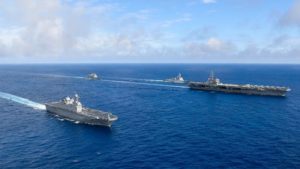
The Real China Hands: What Washington Can Learn From Its Asian Allies
Dr. Michael J. Green – Chief Executive Officer, United States Studies Centre
For four years, as an increasingly belligerent China breathed down their necks, the United States’ allies in Asia quietly endured a torrent of abuse from President Donald Trump. Under President Joe Biden, they again have a winning hand in Washington. By the time he took office, Biden, a leading optimist about cooperation with China when he was vice president, had transformed into a hardened skeptic. He has promoted key alliance builders to the top Asia posts at the National Security Council, the State Department, and the Pentagon and ensured that his first in-person summit was with Yoshihide Suga, then Japan’s prime minister. His administration has elevated the Quad (Quadrilateral Security Dialogue), the group linking the United States with Australia, India, and Japan, to a regular summit and agreed to help Australia build nuclear-powered submarines under the AUKUS pact with that country and the United Kingdom. The White House’s Indo-Pacific strategy, issued in February 2022, mentioned allies or alliances more than 30 times in a 19-page document. China merited only two references.
Despite this welcome attention, the United States still fundamentally gets the relationship with its Asian allies backward. These countries are not reluctant partners that need to be shaken out of their complacency; they live with the threat of China every day, are eager to blunt it, and in fact originated many of the Biden administration’s initiatives to counter the country’s influence. Nor are they reckless novices that fail to understand the dangers of competition with China; they often have a far more subtle understanding of coexistence than the one that prevails in Washington. As it refines its China strategy, the United States should increasingly take its cues from Australia, Japan, and South Korea.
Indeed, as the United States becomes more dependent on allies to maintain a favorable balance of power in the Indo-Pacific, those countries will naturally expect a larger voice in formulating strategy on China. But the United States remains out of sync with its allies on two of the biggest strategic questions: the role that regional free-trade agreements should play in competition with China and the ultimate goal of allied policy toward China. And there are dangerous deficiencies in technology sharing and command and control that need to be addressed. These misalignments are not merely harmless differences between friends. The longer they last, the more China will be able to take advantage of them.
Continue reading here.
Sourced from www.ussc.edu.au


